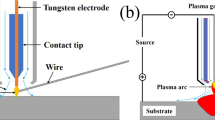Abstract
Ultrahigh strength maraging steels are welded by gas tungsten arc welding (GTAW) over a wide range of thicknesses. However, the speed of conventional GTAW process is limited and hence the deposition rates are less. To enhance the productivity with reduced weld defects, hot wire GTAW (HW-GTAW) process is used to weld maraging steels. Apart from high speed, HW-GTAW provides the benefit of virtual elimination of porosity from the weld deposit resulting into cleaner and faster weld. Unacceptable defects, if any are repaired manually. During the repair, the original weld is gouged to remove the defect then re-filled by manual welding process using filler wire. These repairs affect the mechanical properties and microstructure of original weld. In the present work, effect of the depth of gouging in the original weld of 18%Ni maraging steel on the mechanical properties (tensile strength and hardness) is studied. Effects of burn through (full thickness reweld), from the reinforcement-side (face side) and root side, are also included for one-time repair (R1) and two times repair (R2) conditions. It reveals that strength of weldments decreases and ductility increases with increasing depth of weld repair resulting into wider heat affected zone (HAZ). 6–8% decrease in the strength with respect to virgin weld when the first repair (R1) is carried out by gouging and filling the virgin weld. Very minimal strength decrease is observed when welds are repaired from R1 to R2. Weld microstructure is found to be martensitic with dendrites. Microstructures analysis indicates that reverted austenite formation in HAZ is responsible for reduction in strength. Lowering of microhardness and correspondingly strength is attributed to presence of reverted austenite phase, which is found to increase with increase in gouge depth. Increased gouge depth requires higher heat input and provides scope for wider dark HAZ (HAZ2) with more amount of reverted austenite. Weakest zone is found to be HAZ 2(dark HAZ) where micro-hardness is lowest.










Similar content being viewed by others
References
F.H. Lang, N. Kenyon, Welding of Maraging Steels (WRC Bulletin, New York, 1971), p.159
Specification document (ISRO), Quality requirements for welding & heat treatment of M250 Maraging steel motor case. 2006
P.P. Sinha, S. Arumugham, K.V. Nagarajan, Influence of repair welding of aged 18Ni 250 maraging steel weldments on tensile and fracture properties. Weld. Res. Suppl. 72, 391 (1993)
M. Chidanand, P. Senthil, M. Manohar, S. Biju, P. Uday, G. Rohit, Development of Hot Wire GTAW process for 18% Ni Maraging Steel used for Rocket Motor Casing Accepted (Transactions of Indian Institute of Metals, Kolkatta, 2022)
J.F. Saenger, A.F. Manz, High deposition gas Tungsten arc welding. Weld. J. 47(5), 386–393 (1968)
P.P. Sinha, Maraging steels (Published by Publications & Public Relations, ISRO, India, 2012)
K. Sreekumar, A. Natarajan, P.P. Sinha, K.V. Nagarajan, Microstructural aspects of weld repair in 18 nickel 1800 MPa maraging steel. J. Mater. Sci. 27, 3817 (1992)
A. Bilal, T. Fawad, N. Nausheen, B. Rasheed, How multiple weld repairs impact maraging steel. Weld. J. 91, 38–47 (2012)
J.J. Pepe, W.F. Sawage, The weld heat affected zone of 18 Ni maraging steels; welding research supplement. Suppl. Weld. J. 49, 545 (1970)
R.F. Decker, J.T. Eash, Goldman, eighteen percent Nickel maraging steel. Trns. ASM 55, 58–76 (1962)
R. Chidan, S. Magadum, R. Cherian, M. S. Kurup. Weld Repair Studies on 78 mm thk M250 Maraging Steel.
D.T. Peters, C.R. Cupp, The kinetics of aging reactions in 18 pct Ni maraging steels. AIME Met. Soc. Trans. 236(10), 1420–1429 (1966)
T. Fawad, S. Madni, B. Rasheed Ahmed, Effect of overaging conditions on microstructure and mechanical properties of maraging steel. Metal Sci Heat Treat. 62, 188–194 (2020). https://doi.org/10.1007/s11041-020-00535-y
U.K. Vishwanathan, G.K. Dey, M.K. Asundiu, Precipitation hardening in 350 grade maraging steel. Metall. Transact. A 24, 2429–2442 (1993)
B. Rohit et al., Austenite reversion in 18%Ni maraging steel & its weldments, materials science & technology. Mater. Sci. Technol. (2017). https://doi.org/10.1080/02670836.2017.1407544
K. Ramesh Narayanan, S. Sreekumar, A. Natarajan, P.P. Sinha, Metallographic investigations of the heat affected zone II/parent metal interface cracking in 18 Ni maraging steel. J. Mater. Sci. 25, 4587–4591 (1990)
K. Vasudevan Vijay, J. Kim Sung, C. Wayman, Marvin Precipitation reactions and strengthening behavior in 18 wtpct nickel maraging steels. Metall. Transact. A. 21A, 2655–2668 (1990)
G. Renu et al. Key hole plasma arc welding of 8mm thick maraging steel—A comparison with multi pass GTAW, Welding in the world, (2012).
L. Subashini, K. Prabhakar, V. Phani, C. Gundakaram Ravi, G. Padmanabham, Single pass laser-arc hybrid welding of maraging steel thick sections. Mater Manuf. Process. 31, 2186–2198 (2006)
Y.J. Lee, I.K. Lee, S.C. Wu, M.C. Kung, P.C. Chou, Effect of post weld heat treatment on microstructure and mechanical properties of electron beam welded flow formed maraging steel weldment”. Sci. Technol. Weld. Join. 7, 266 (2007)
Funding
The authors declare that no funds, grants, or other support were received during the preparation of this manuscript.
Author information
Authors and Affiliations
Corresponding author
Ethics declarations
Conflict of interest
The authors have no relevant financial or non-financial interests to disclose.
Additional information
Publisher's Note
Springer Nature remains neutral with regard to jurisdictional claims in published maps and institutional affiliations.
Rights and permissions
Springer Nature or its licensor (e.g. a society or other partner) holds exclusive rights to this article under a publishing agreement with the author(s) or other rightsholder(s); author self-archiving of the accepted manuscript version of this article is solely governed by the terms of such publishing agreement and applicable law.
About this article
Cite this article
Magadum, C., Gupta, R.K., Senthil, P. et al. Study on Effect of Gouge Depth on the Microstructure and Tensile Properties of 18%Ni Maraging Steel Welds Made Through Hot Wire GTA Welding. J. Inst. Eng. India Ser. D 104, 785–794 (2023). https://doi.org/10.1007/s40033-022-00430-1
Received:
Accepted:
Published:
Issue Date:
DOI: https://doi.org/10.1007/s40033-022-00430-1




